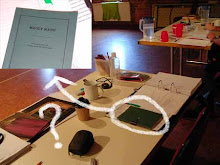
The show returns to the stage after having a night off. Everybody has been telling me that the show has been getting better and better, so I'm excited to see it again after missing a couple of nights.
The first Tuesday in a season at the Malthouse is “Time To Talk” night. Peter Clarke hosts the session, which is a forum where audiences have the opportunity to speak to the creatives and performers about the show. Thanks must go to Peter for facilitating the discussion; he is so informed about theatre and is such an accomplished communicator that I couldn't imagine anybody doing a better job.
I made some notes on the forum. Some of what came up we have covered already in the blog, but there was plenty of new stuff too. Of course, it's also interesting to hear what questions people have about the show. Because of the sheer volume I’ve decided to break it up into 2 separate posts.
Peter opened up the forum by asking Chris and Lally about the relationship between research and theatre, and what the genesis of the piece was.
As we know, nearly 4 years ago Chris discovered a book called “Act as Known” by Valentyne Napier in a Brunswick Street book shop. Napier’s parents spent their lives in vaudeville and were famous for their Spider and Butterfly act. Their lives, and the lives of the other performers and the theatres they worked in are the subject of Napier’s book. This book sparked Chris’s interest in working on a show inspired by Australian vaudeville.
Chris and Lally then successfully applied for a residency at the State Library of Victoria to research Australian vaudeville acts. The pair were especially interested in the forgotten people of history; the ones who are not celebrated by history. Rather, the ones that fell through the cracks, and can only be found in small newspaper articles or pieces of ephemera.
Lally's research was more hap-hazard. She would get stuck musing on a particular article, or find herself reading unrelated advertisements. Chris was more methodical and would drive Lally towards articles and information of note.
One particular theme that came up a lot in their research was how often drownings in the Yarra River would be reported on. The river gained a monstrous persona that would rise up to absorb people into itself; drowning them and burying them in mud.
They also mentioned the influence on the work of entertainment entrepreneur Harry Rickards. (There's a link to his bio on the right.)
One of the audience members asked how the actors dealt with the form and style of the piece, given the different styles of the two acts, and the quite specific requirements of vaudeville?
Matt responded by saying that for him it was quite a natural extension from the direct style of presentation that is used in circus.
Christen said that her greatest concern was in the ventriloquism. It's a highly skilled art form in its own right, and although she was continually told that her character was not a good ventriloquist, performing something badly is not necessarily any easier than performing it well. She went on to say that the two acts provide two distinct challenges. The first act requires immersion in the world of vaudeville. The second act requires what Christen called 'capital M Magic'- big emotion, big moments, bold commitment. Addressing these two different approaches in a single show was a big challenge.
Julia talked about understanding the world of the piece, and how it only crystalised for her once she was playing on the set and working in the costumes. These things were crucial in her development of the character.
Alex responded that he saw it quite simply; he tries to do what the director tells him to do.
Jim said he had a couple of ways in. One of which was the voice of John Meillon's character in The Picture Show Man.
The discussion moved on to design. Jonathon was roundly applauded for his work on the costume and set. As was Richard, for his lighting.
Richard revealed the way he had approached the contrast between the two acts in respect of the lighting design. He said that the first act was defined to a large degree by the footlights, a traditional feature of the old theatres. Footlights tend to flatten a space, and this became the primary feature of the design. But, in the second act he was working to make the performers and the space more three dimensional. He also wanted to give the performers the impression of being ghosts, that would at times feel as though they were floating in the space.
More from the Time To Talk tomorrow! I've moved the Countdown clock to when the show ends, so if you've not seen it yet get down to the Malthouse. It will close faster than you think!





